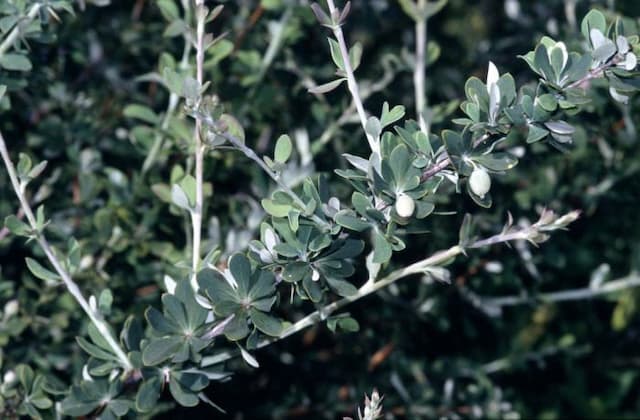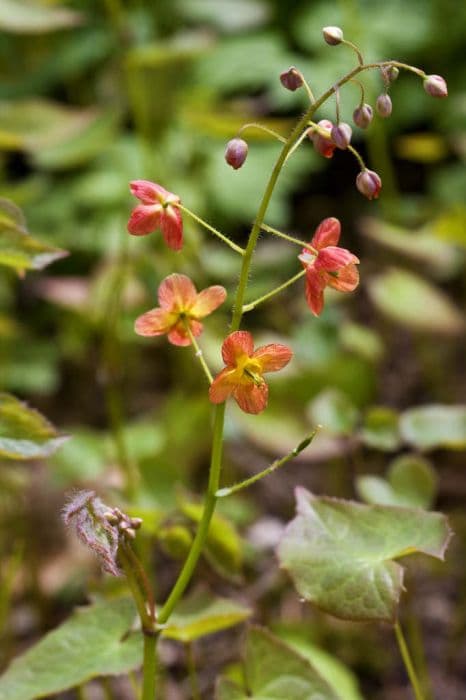Horny Goat Weed Epimedium brevicornu

ABOUT
Epimedium brevicornu, commonly known as horny goat weed, has a distinctive appearance notable for its eye-catching foliage and flowers. The leaves are heart-shaped with a slightly spiny edge, emerging with a red-bronze tint before maturing to a rich green as the seasons progress. In the fall, the leaves may change to a fetching reddish color, adding ornamental value. The plant is particularly admired for its flowers that blossom in spring, comprising delicate, small, four-petaled blooms arrayed in loose, open clusters. The flowers display a charming color palette, typically featuring a soft hue with a lighter center, creating an ethereal effect as they seem to float above the foliage on wiry stems. This plant's aesthetic is further embellished with a subtle texture, as its foliage exhibits a leathery surface with a glossy sheen, making it an attractive ground cover even when not in bloom. The overall impression of horny goat weed is a pleasing blend of form, color, and texture, making it a favorite for gardeners looking to add interest to their shade gardens or woodland plantings.
About this plant
 Names
NamesSynonyms
Horny Goat Weed, Fairy Wings, Yin Yang Huo, Barrenwort, Bishop's Hat, Longspur Epimedium.
Common names
Epimedium alpinum var. brevicornu, Epimedium koreanum Nakai.
 Toxicity
ToxicityTo humans
The plant Epimedium brevicornu, commonly known as Horny Goat Weed, is not typically considered toxic to humans. However, like with any plant, individual reactions can vary, and there is potential for adverse effects, particularly when consumed in large amounts or in concentrated forms such as supplements. Consuming Horny Goat Weed may lead to various side effects such as dizziness, dry mouth, nosebleed, or mood changes. People with certain health conditions or those taking particular medications should consult with a healthcare provider before using Horny Goat Weed as a supplement due to potential interactions and side effects.
To pets
Horny Goat Weed, the common name for Epimedium brevicornu, is not widely recognized as a toxic plant to pets. There is limited information on its effects in domestic animals like dogs and cats. As is the case with many plants not typically used for animal consumption, it is advisable to prevent pets from ingesting Horny Goat Weed due to the potential for unforeseen reactions. If a pet does consume this plant and displays signs of distress such as vomiting, diarrhea, or unusual behavior, it is important to consult a veterinarian.
 Characteristics
CharacteristicsLife cycle
Perennials
Foliage type
Deciduous
Color of leaves
Varies
Flower color
Yellow
Height
1 feet 10-12 inches (30-35 cm)
Spread
1 feet 10-12 inches (30-35 cm)
Plant type
Herb
Hardiness zones
5
Native area
China
Benefits
 General Benefits
General Benefits- Enhanced Drought Tolerance: Epimedium brevicornu, commonly known as Horny Goat Weed, typically exhibits good resistance to periods of dryness once established, reducing the need for frequent watering.
- Ground Cover: It can serve as an effective ground cover, spreading to fill in areas and suppress weeds by creating a dense foliage barrier.
- Shade Tolerance: This plant is capable of thriving in partially shaded environments where other plants may struggle, making it versatile for different garden settings.
- Attracts Pollinators: The flowers of Horny Goat Weed can attract pollinators such as bees and butterflies, which are essential for the health of any garden ecosystem.
- Low Maintenance: Once established, Epimedium brevicornu requires minimal care, which makes it consumer-friendly for gardeners who prefer plants that do not require constant attention.
- Seasonal Interest: The plant offers visual interest across multiple seasons with its flowers in spring and foliage that can change color in the fall.
- Soil Adaptability: It adapts to a range of soil types, from sandy to loamy to clay, although it prefers well-drained conditions.
- Erosion Control: The dense root system of Horny Goat Weed can help stabilize soil and prevent erosion on slopes or in areas prone to soil loss.
 Medical Properties
Medical Properties- Libido enhancement: Often referred to as "Horny Goat Weed," Epimedium brevicornu is traditionally used to increase sexual desire.
- Erectile dysfunction: It is believed to help with erectile dysfunction by increasing blood flow to the genital area.
- Osteoporosis treatment: It has been used in traditional Chinese medicine to strengthen bones and prevent bone loss.
- Anti-inflammatory effects: Contains compounds that may help reduce inflammation in the body.
- Antioxidant properties: The plant is thought to have antioxidants that protect cells from damage by free radicals.
- Immune system support: May contribute to the enhancement of the immune system.
 Air-purifying Qualities
Air-purifying QualitiesThis plant is not specifically known for air purifying qualities.
 Other Uses
Other Uses- Decorative ground cover: Epimedium brevicornu, commonly known as Horny Goat Weed, can be used in landscaping as an attractive ground cover, thanks to its heart-shaped leaves and vibrant flowers.
- Shade garden enhancement: It thrives in shady areas, making it a perfect addition for garden spots that don't receive much sunlight.
- Drought-resistant planting: Once established, this plant is drought-tolerant, making it suitable for regions with low rainfall or for water-conserving gardens.
- Erosion control: Its dense growth habit helps stabilize soil on slopes or areas prone to erosion.
- Butterfly and bee attractant: The flowers of the Horny Goat Weed can attract pollinators, which is beneficial for the garden ecosystem.
- Living mulch: It can be used as living mulch by providing a natural, weed-suppressing layer under taller plants or trees.
- Seasonal interest: With leaves that change color in the fall, it can add seasonal interest to a garden.
- Border planting: Its compact and spreading habit makes it suitable for edging or border fronts in garden designs.
- Container gardening: Horny Goat Weed can be grown in pots or containers, where it can be managed more easily and moved around as needed.
- Compatibility with spring bulbs: It pairs well with spring-blooming bulbs, as it can provide foliage interest after the bulbs have faded.
Interesting Facts
 Feng Shui
Feng ShuiThe plant Horny Goat Weed is not used in Feng Shui practice.
 Zodiac Sign Compitability
Zodiac Sign CompitabilityThe plant Horny Goat Weed is not used in astrology practice.
 Plant Symbolism
Plant Symbolism- Longevity: Epimedium brevicornu, also known as Horny Goat Weed, is often connected with longevity due to its medicinal properties that are believed to enhance life span and vitality.
- Sexual Vitality: As its common name suggests, Horny Goat Weed is widely regarded as a natural aphrodisiac, symbolizing sexual health and improved libido.
- Resilience: This plant is known for its ability to thrive in tough conditions, making it a symbol of resilience and adaptability.
 Water
WaterFor the Barrenwort, it's essential to maintain moderately moist soil, especially during the spring and summer growing seasons. Typically, water it once a week, providing about one inch of water each time, or approximately two-thirds of a gallon for an established plant in a garden setting. Adjust the frequency slightly based on weather conditions; more water may be needed during periods of drought or less during rainy spells. Ensure proper drainage to avoid waterlogging, as this can lead to root rot. During the winter, when the plant is dormant, reduce watering but do not allow the soil to become completely dry.
 Light
LightBarrenwort thrives under dappled shade or in areas of partial light. It is best situated in a spot where it can receive filtered sunlight, making it a suitable understory plant beneath open canopies of trees. Direct afternoon sun should be avoided as it can scorch the leaves, whereas too deep shade can result in fewer flowers. A north-facing or east-facing location usually offers the ideal lighting conditions for this plant.
 Temperature
TemperatureBarrenwort performs well in a range of temperature conditions but prefers a climate where the temperatures remain between 50°F and 75°F. It is hardy and can survive temperatures down to -30°F, making it suitable for many temperate regions. The plant can also tolerate heat up to around 85°F; however, prolonged exposure to temperatures higher than this can stress the plant.
 Pruning
PruningPrune Barrenwort to remove any damaged or dead foliage and to maintain a tidy appearance. Pruning is best done in late winter or early spring, before new growth starts. Cut the plant back by about one-third every few years to rejuvenate it and encourage robust new growth. Regular pruning isn't necessary; focus on trimming only when necessary to shape the plant or when old leaves become unsightly.
 Cleaning
CleaningAs needed
 Soil
SoilBishop's hat requires well-draining soil with high organic matter. Aim for a slightly acidic to neutral pH of around 6.0 to 7.0. A mix of loam, peat, and a small amount of perlite or sand is ideal to ensure proper drainage and aeration.
 Repotting
RepottingBishop's hat should be repotted every two to three years or when it becomes root-bound. It's best to repot in the spring, before the new growth starts, to minimize stress on the plant.
 Humidity & Misting
Humidity & MistingBishop's hat thrives in moderate humidity levels ranging from 30% to 50%. It can tolerate lower humidity levels, but consistent moisture in the air helps maintain its health and vigor.
 Suitable locations
Suitable locationsIndoor
Provide bright indirect light and moist, well-draining soil.
Outdoor
Plant in partial shade with moist, well-draining soil.
Hardiness zone
5-9 USDA
 Life cycle
Life cycleEpimedium brevicornu, commonly known as Horny Goat Weed, begins its life as a seed, which requires a period of cold stratification to break dormancy before germination can occur. Upon germination in the spring, the seedling grows into a small rosette of heart-shaped leaves, which is characteristic of juvenile plants. As the plant matures, it develops a rhizome system from which new shoots and a larger clump of foliage emerge. The plant reaches reproductive maturity within a few years, producing sprays of small, colorful flowers in the spring, often white, yellow, or purple, which are pollinated by insects. After pollination, seed pods develop and eventually release seeds, continuing the reproductive cycle. To complete its lifecycle, Epimedium brevicornu enters a period of dormancy over the winter months, with foliage dying back and growth resuming again with the return of warmer temperatures.
 Propogation
PropogationPropogation time
Spring to early summer
The most popular method of propagation for Epimedium brevicornu, commonly known as Horny Goat Weed, is by division. This is typically done in either the spring or fall. Gardeners dig up the clumping perennial plants, ensuring they have a sizable root mass. The clumps are then carefully separated into smaller sections, making sure that each new piece has at least one growth point, which is usually a segment of rhizome with buds. These individual divisions are then replanted in the soil at the same depth they were originally growing, spaced about 12 to 18 inches apart (30 to 45 centimeters). They should be watered well to help establish roots in their new location. Over time, the divisions will grow into full-sized plants, continuing to spread and fill in the area.









